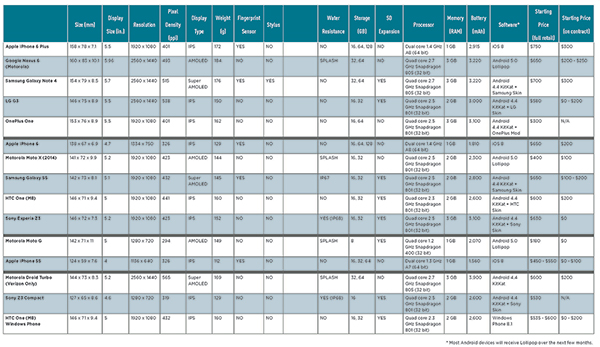 In the beginning (all the way back to 2007), there was only one smartphone and one operating system that mattered: the Apple iPhone and its iPhone OS (now iOS). 2008 saw the introduction of Google-backed Android phones (as well as a second iPhone model), and though Android’s first offerings lacked the polished design and smooth operation of their iPhone contemporaries, Android phones were more affordable and more open to customization and became the more accessible option on a worldwide scale. With thousands of distinct device options available from hundreds of manufacturers, Android now dominates the world market in total sales and usage. Apple, meanwhile, as the sole maker of iOS devices, continues to be the top device manufacturer in the United States, beating out top Android maker Samsung.
In the beginning (all the way back to 2007), there was only one smartphone and one operating system that mattered: the Apple iPhone and its iPhone OS (now iOS). 2008 saw the introduction of Google-backed Android phones (as well as a second iPhone model), and though Android’s first offerings lacked the polished design and smooth operation of their iPhone contemporaries, Android phones were more affordable and more open to customization and became the more accessible option on a worldwide scale. With thousands of distinct device options available from hundreds of manufacturers, Android now dominates the world market in total sales and usage. Apple, meanwhile, as the sole maker of iOS devices, continues to be the top device manufacturer in the United States, beating out top Android maker Samsung.
There have, of course, been other smartphone options along the way — webOS, BlackBerry, and now Windows Phone, to name a few – but in 2015, the best smartphones continue to bear the marks of Apple or Android. Unlike years past, however, when competitions for the “best” smartphone often boiled down to two- or three-horse races (usually between the newest iPhone and the top one or two Android devices), the field is now so full of thoroughbreds and budget-friendly (yet truly capable) dark horses alike, it’s hard to know where to begin. Indeed, having so many great phones to choose from may appear to be a consumer’s dream, but the paradox of choice is that it can also be a nightmare of stress and second guessing.
To further complicate things, there are now so many size and feature variations among smartphones that having an all-around “best smartphone” no longer makes sense. Especially for attorneys, who exhibit a very wide range of work (and play) styles, there is no one “best” option. The good news is that the smartphone races of today now have many events, and all of the phones discussed in this shootout-turned-roundup are “safe bets” to do well in at least a few. So sit back, relax, and read on to find out which of the day’s top contenders may be the best option for your individual needs.
Pick Your Winning Smartphone Model!
Click on the image to view larger version of smartphones specifications chart, or view the PDF.

The Field: “Phablets”
iPhone 6 Plus
A couple of years ago, the idea of an iPhone sporting a 5.5” display was almost unthinkable, but Apple couldn’t ignore consumer demand for ever-growing phones forever. Apple’s first foray into Phablet-land is a solid offering. It sports a sleek build, Apple’s well-known and intuitive iOS interface, fingerprint sensing and mobile payment that actually work, and a truly superior camera (the best of any phone here). In fact, unless you recently spent more than $500 on your “real” camera, you can probably just leave it at home. A final note: you may have heard news stories about these phones bending, but unless you wear skinny jeans to the office and never take your phone out of your pocket, I wouldn’t worry about it under normal use. Buy this phone if you have already bought into Apple’s ecosystem and need a large screen for reading lots of email and documents (or gaming), or if you need a stellar camera for digitizing documents in low light (or, you know, for vacation).
Tell Us!
Recently purchase a smartphone? Tell us about your experience. Post a comment below.
Google Nexus 6 (Motorola)
Google’s latest Nexus phone – meant to be the purest embodiment of Android – is a beast: a big, beautiful, powerhouse of a beast, with specs that can’t be beat and enough real estate (nearly 6” of screen!) that you can go ahead and just sell your small tablet. It will, however, be unwieldy for most. There is no built-in one-handed mode, so unless you are Troy Aikman (with his giant mitts), you will need to alter the way you use your phone. If you can adapt to two-handed use, you’ll be in for a treat. Buy this phone if you are an Android purist and want the very biggest, fastest, and strongest (build quality is excellent) phablet around. If you love photography, however, look elsewhere – while the camera is much improved over previous Nexus devices and “good enough” for most situations, its low-light performance still isn’t great.
Samsung Galaxy Note 4
The Note 4 is a fantastic phone – the best Samsung has ever produced. It boasts a large interchangeable battery, microSD expansion, and a better-than-average camera, and its accurate and beautiful Quad HD 5.7” Super AMOLED screen may be the best of any phone since … well, ever. It also feels surprisingly good in the hands for such a large device. Some Android purists will be put off by some of the “bloat” added by Samsung’s custom TouchWiz skin, but a few of the additions are useful, and the existence of a stylus will please many. Buy this phone if you wish to experience the very state of the art in phablet design and overall usability – all on a gorgeous screen.
LG G3
The LG G3 may be aging, but its specs were so good when it came out that it remains one of the best devices available today – and an excellent value given recent drops in price. Like the Note 4, it boasts a super-sharp (albeit not as bright) QHD display, and at 5.5”, has the same screen size as the iPhone 6 Plus. Its footprint, however, is not that much bigger than the One-handed Flagship phones listed below, making it the Phablet category leader in one-handed usability. It also has nifty split-screen multitasking (as do both Samsung devices), a very good camera, a swappable “good enough” battery, and microSD expansion. Buy this phone if you want a big screen that might actually fit in your hand and pocket, or if you are simply looking for one of the best deals around.
OnePlus One
You may not have heard of OnePlus, but if it keeps making phones like the “One,” you will. This 5.5” “flagship killer” of a phone sports very highly customizable software and powerful specs, but costs less than half of what you’d pay for a Nexus 6, Note 4, or 6 Plus. The only problem (at least at the time of this writing) is limited availability. The One can only be purchased off contract, and you usually need an “invite” to do so. OnePlus has been opening up purchases to the public on a limited basis more recently, however, so by the time you read this, this could be a nonissue. Buy this phone if you are buying off contract and want top-notch power at an absurdly low cost.
The Field: “One-handed Flagships”
iPhone 6
Ahhh yes, the iPhone 6. Is it the “best iPhone ever”? The short answer is yes, yes it is. It’s fast, it’s thin, and it’s finally big enough for people over 40 (or 25, if they went to law school) to read documents on. Though there have been a few more hiccups than usual with the new iOS8, the single biggest argument for all things Apple – that it “just works” – is, for the most part, still very true. So, if you want a beautifully designed phone that is easy to use (and if you do have trouble, there will likely be someone that can help within earshot), there is no better option. It also has a fantastic camera, second only in this roundup to the 6 Plus. Buy this phone if you are new to smartphones, if you are a Mac power user, if your family uses Facetime or iTunes a lot (new family sharing of iTunes purchases is fantastic), or if you just like pretty things that work well.
Try to handle as many [phones] as you can in person before you make your choice.
Moto X 2nd Gen. (2014)
The Moto X 2014 doesn’t seem like much on a spec sheet. It doesn’t have expandable storage (32 GB max), doesn’t have a very large battery, and doesn’t have the best screen or camera – but despite these shortcomings, it still manages to be one of the best Android experiences around. In large part, this is due to its nearly pure form of Android, which runs fast and only has a few (surprisingly welcome) additions from Motorola: Moto Voice, Moto Assist, Moto Actions, and Moto Display. While most Android phones suffer from unnecessary gimmicky additions, the Moto X’s extras all add positively to the Android experience.
The Moto X 2014 is also the most stylish and customizable of this year’s phones. Using Moto Maker, online or in store, you can choose between a variety of real leather, real wood, and plastic finishes (also real), as well as several trim and screen color combinations. Regardless of your build choice, the quality is excellent, and the “splash” resistant phone, with its 5.2” screen, feels great in the hand. The Moto X 2014 is also less expensive than the other flagships, making it a true value. Buy this phone if you want a high-value, personalized device with a purer form of Android.
Samsung Galaxy S5
Samsung’s latest entrant from its popular Galaxy line, the 5.1” S5, offers an excellent, very vibrant display, a feature-rich camera, and removable battery and expandable storage. It also has some less common features, such as a heart rate scanner, a fingerprint reader (though it doesn’t work nearly as well as Apple’s), and an IP67 rating, meaning it is dust and water resistant (but not dustproof and waterproof like the Sony Z3 and Z3 Compact). Its creaky plastic design, however, with a phone back that is oddly reminiscent of a bandage, does not measure up to the build standards of Apple, HTC, Motorola, or its Note 4 cousin.
Still, the S5 is very powerful, and does a lot of things very well. Buy this phone if you want a fast phone with a good camera and moderate protection from the elements – or if you like Samsung’s TouchWiz interface, but find the Note 4 too big.
HTC One (M8)
With its solid metal body, the aging HTC One (M8) (new model likely soon) is a beautifully crafted and fantastic-to-hold phone with built-in stereo speakers that are truly the best around (although no phone really has great sounding external speakers, this is the only one around with good sounding ones). One’s camera does not offer the sharp resoluion as many of its rivals, but it is fast and can produce some nice images with its built-in creative effects. The phone itself is also fast, and despite its smallish battery, will last all day. Buy this phone if you listen to music without headphones or you want the most premium-feeling phone available that doesn’t have an Apple logo on its back.
Sony Xperia Z3
The only phone in this roundup that is fully waterproof, the Z3 also boasts exceptional (nearly two-day) battery life and a very good, very bright screen, which makes it easier to read in sunlight. The camera is also quite powerful, but it is a bit difficult to master, and ultimately not as good as either of the iPhones or the LG G3. Its excellent metal-framed and glass-backed build nearly rivals the premium feel of the HTC One (though the Z3 is not as ergonomic) and external sound is also very good (though again, not as good as the HTC One).
 Tison Rhine is the advisor to the State Bar of Wisconsin Law Office Management Assistance Program (Practice411™).
Tison Rhine is the advisor to the State Bar of Wisconsin Law Office Management Assistance Program (Practice411™).
For attorneys who like to wind down playing “real” (nonphone) video games, the Z3 gains an edge on other phones with its PS4 Remote Play feature, allowing gamers to play their Playstation4 games anywhere in their home, using their Z3 and Dualshock4 controller. For any potential buyer, though, a word of caution: Verizon’s Z3v model has an inferior design. Buy this phone if you want a premium phone you can take outdoors (or into a bath), or if you would like to play PS4 games anywhere in your home.
The Field: “Capable Budget Phones”
Motorola Moto G
The Moto G lacks the high-end specs of the Moto X, but it does have one feature that the Moto X lacks – expandable storage. Other than that, it retains a fairly pure form of Android and is my pick for the best (widely available) Android phone for those on a budget.
iPhone 5S
The iPhone 5S remains a great choice for those who want a fast, easy-to-use iOS device with a smaller form factor. Because it’s more than a year old, you can now get this phone on contract for a song.
Honorable Mentions
Motorola Droid Turbo (Verizon Only)
The Droid Turbo is like a Moto X on steroids: it has better specs all around (including incredible pixel density and excellent battery life), but adds some bulk in the process. It may not be as pretty, but it is an amazing phone and would have been discussed above if it were available on more carriers.
Sony Z3 Compact
The Sony Z3 Compact may be less powerful and have a lower-res screen than its bigger Z3 sibling, but it has equal or better battery life, is cheaper, and feels a lot better in the hand. If you are looking for a smaller Android device with near flagship specs, this is the one. You’ll need to pay full price, though, as none of the major carriers offer it on contract.
HTC One (M8) – Windows Phone
There are Lumias with better cameras, but if you must have a Windows Phone, get this one.
Wrap Up
We’ve come a long way since 2007, and every single one of the phones in this roundup has the potential to be the “best” phone for the right person. Try to handle as many as you can in person before you make your choice. But try not to let the sales team sway you – you now know what you need more than they do.
